ISSN: 2563-0261
Every year, we conduct surveys to support plant health in Canada.
The Canadian Food Inspection Agency's (CFIA) Plant Health Survey Program supports plant health by detecting new pests and by monitoring the spread of established pest populations, forming the basis for sound regulatory decisions. Surveillance data collected by trapping, visual inspection and sampling efforts contribute to policy development and trade negotiations. Plant health surveillance activities also support Canada in meeting the International Standards for Phytosanitary Measures.
These survey results are collected between April 1, 2023, to March 31, 2024.
Survey results
Forest pests
Emerald ash borer
The emerald ash borer (Agrilus planipennis) was first detected in Canada in Windsor, Ontario, in July 2002. Since the initial detection, this species has been found in Winnipeg, Manitoba, and parts of Ontario, Québec, New Brunswick and Nova Scotia. The primary goal of this survey is to determine whether emerald ash borer is present in areas where it is not known to occur in order to provide information in support of regulatory decisions.
Method: Visual inspection and traps
Two main strategies were used for emerald ash borer detection in Canada:
- visual inspection of trees
- trapping using green prism traps baited with attractants
Target sites for this survey include areas showing broad-scale ash decline and high-risk sites where the pest is most likely to have been introduced through human activities, such as campgrounds, firewood dealers, rest stops along major transportation corridors, urban areas recently planted with host material, sawmills, and holiday destinations. Traps were also deployed within select urban centers using a grid-based approach.
Results from 677 surveyed sites
| Provinces | Number of sites surveyed | Results |
|---|---|---|
| British Columbia | 88 | One adult beetle was intercepted in Vancouver. |
| Alberta | 64 | - |
| Saskatchewan | 10 | - |
| Manitoba | 62 | - |
| Ontario | 92 | Detections in Oliver-Paipoonge 2km outside the Thunder Bay regulated area. |
| Quebec | 197 | Detections in Carleton-sur-Mer, in the Regional County Municipality (MRC) d'Avignon, Mont-Joli, in the MRC of La Mitis, and in Témiscaming in the MRC of Témiscamingue. |
| New Brunswick | 39 | - |
| Nova Scotia | 93 | - |
| Prince Edward Island | 16 | - |
| Newfoundland and Labrador | 16 | - |
| Canada | 677 |
In 2023, collaborators submitted data for over 200 sites surveyed for this pest, which resulted in one new detection in western Quebec, and additional detections in Carleton-sur-Mer outside the current regulated areas. A report made by a member of the public also resulted in the interception of emerald ash borer in Vancouver. However, no evidence of an active population was confirmed in host trees in the vicinity. Enhanced monitoring of the area will continue in 2024. Additional surveys will be conducted around newly infested areas in 2024 to inform regulatory decisions. |
Map of results
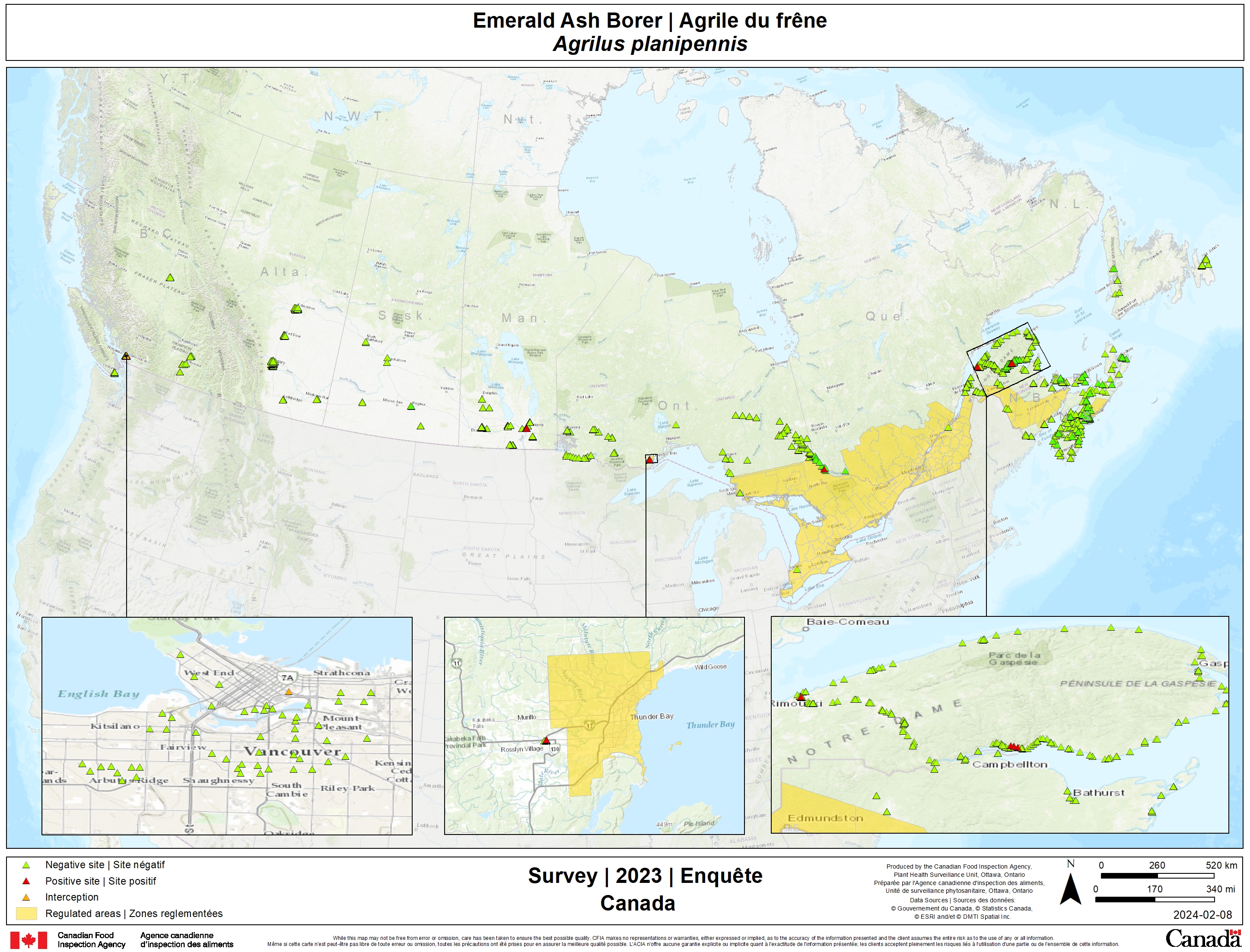
The map shows the locations of the 677 surveyed sites for emerald ash borer in 2023, covering all Canadian provinces. The regulated areas for emerald ash borer are shaded with yellow and cover part of New Brunswick, Nova Scotia, Quebec and Ontario, and the city of Winnipeg.
There are 491 negative sites shown as green triangles extending the entire area surveyed. Nine red triangles indicate positive sites where the beetle was detected outside the regulated areas, in Gaspésie and Témiscamingue (Quebec) and outside Thunder Bay (Ontario). One orange triangle shows an interception in Vancouver.
Spongy moth and flighted spongy moth complex
The spongy moth (Lymantria dispar dispar), formerly known as the European gypsy moth, is established in Ontario, Québec, New Brunswick, Nova Scotia and in Prince Edward Island. Pheromone-based monitoring surveys are conducted annually in non-regulated areas of Canada. Surveys are also conducted to verify eradication of the insect in areas where eradication programs have been undertaken.
The flighted spongy moth complex (Lymantria dispar asiatica, Lymantria dispar japonica, L. albescens, L. postalba and L. umbrosa) includes related species formerly grouped under the name Asian Gypsy Moth and has been introduced into North America on several occasions, but eradication programs have prevented populations from establishing. This survey is being conducted in support of D-95-03: "Plant protection policy for marine vessels arriving in Canada from areas regulated for AGM (Lymantria dispar, Lymantria albescens, Lymantria postalba, Lymantria umbrosa). The flighted spongy moth complex is defined for regulatory purposes as those subspecies of Lymantria dispar in which the females are capable of sustained directed flight, whereas the spongy moth (Lymantria dispar dispar) females are not capable of flight.
Method: Traps
Trapping is performed using sticky traps baited with attractants. Two trapping systems can be used depending on the area's status to survey:
- detection trapping is used to determine if European spongy moth is present in an area currently considered free from the pest
- delimitation trapping is used to determine the extent of a population once a detection has been confirmed.
The two systems use different trapping densities. Trapping is focused on areas where the risk of introduction is greatest, for example: ports, container storage yards, intermodal terminals, industrial zones, tourist destinations, campsites and parks, some transportation corridors, etc.
Results from 13,716 surveyed sites
| Provinces | Number of sites surveyed | Results |
|---|---|---|
| British Columbia | 10,166 | Detections:
|
| Alberta | 1,628 | Detections:
|
| Saskatchewan | 719 | Detections:
|
| Manitoba | 654 | Detections:
|
| Ontario | 126 | Detections:
|
| Quebec | 126 | - |
| New Brunswick | 5 | - |
| Nova Scotia | 15 | - |
| Prince Edward Island | 5 | - |
| Newfoundland and Labrador | 370 | Detections:
|
| Canada | 13,716 |
In 2023, collaborators assisted by surveying more than 1500 sites. No moths of the flight capable flighted spongy moth complex were found in Canada in 2023, including traps set in Spongy Moth regulated areas of Ontario, Quebec, New Brunswick, Prince Edward Island and Nova Scotia. Planned treatments in BC include North Saanich, Esquimalt, Gorge-Tillicum, Belmont/Langford Salt Spring Island, Nanaimo, Qualicum Beach, Cowichan Bay, Cranbrook, Kamloops, Kelowna West, Langley and Tsawwassen. Delimitation trapping will continue at all sites where spongy moth was detected in 2024. |
Map of results
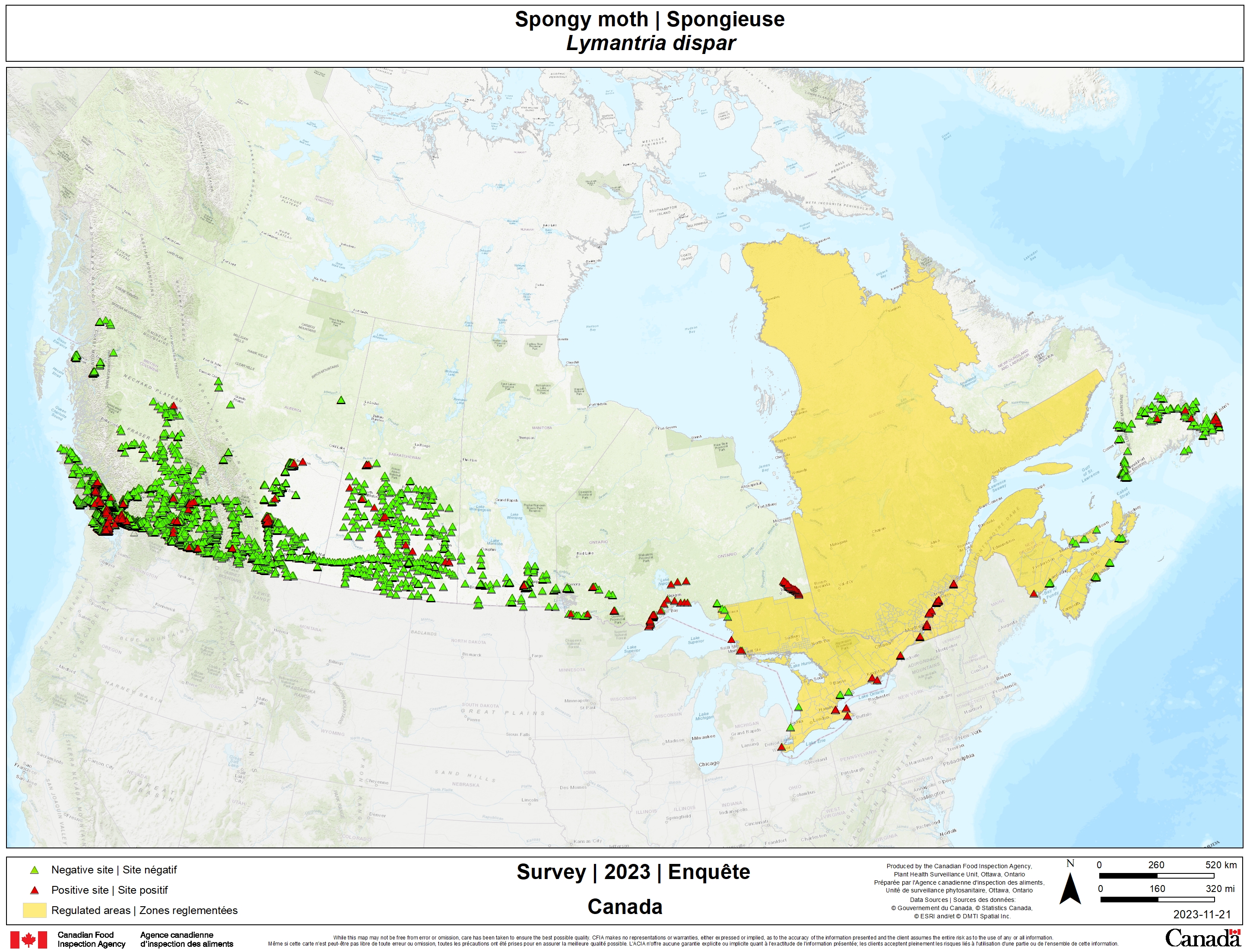
The map shows the locations of sites that have been surveyed for Spongy moth in 2023 covering all provinces. The regulated areas for this pest are shaded with yellow and cover the entire provinces of Quebec, New Brunswick, Nova Scotia, Prince Edward Island, and part of the province of Ontario.
There are 13,176 sites shown as green and red triangles extending the entire area surveyed. Red triangles indicate 320 positive sites where the moth was detected. There were detections in all provinces except Prince Edward Island and Nova Scotia.
Brown spruce longhorn beetle
The brown spruce longhorn beetle (Tetropium fuscum), an introduced wood boring pest, is native to north and central Europe and Japan, where it uses stressed and dying conifers as hosts, most notably Norway spruce (Picea abies). All species of spruce in Canada are at risk. In 1999, the beetle was detected in Point Pleasant Park, Halifax, Nova Scotia, and confirmed to have been present since at least 1990. The brown spruce longhorn beetle is considered to be a pest of quarantine significance in Canada and is regulated under the Plant Protection Act by the CFIA. The entire province of Nova Scotia is regulated for this pest.
Method: Traps
Panel traps baited with pheromones are used for this survey. Trapping is conducted at 2 types of sites:
- priority sites such as sawmills, pulpmills, campgrounds and ports
- general forested areas
This survey is performed in Eastern provinces to prevent further spread from the known infested areas.
Results from 388 sites surveyed
| Provinces | Number of sites surveyed | Results |
|---|---|---|
| Quebec | 81 | The pest was intercepted in Saint-Honoré-de-Shenley in the Beauce-Sartigan regional county municipality. No established populations have been confirmed following the onsite investigation. |
| New Brunswick | 236 | The pest was intercepted in Fredericton. No established populations have been confirmed following the onsite investigation. |
| Nova Scotia | 3 | - |
| Prince Edward Island | 40 | - |
| Newfoundland and Labrador | 24 | - |
| Canada | 388 |
The survey was conducted in 140 municipalities in five provinces. Collaborators assisted by surveying more than 30 sites. The interception in Saint-Honoré-de- Shenley is the first time this pest has been found in the province of Quebec. Additional delimitation surveys will be conducted in 2024 around these interceptions to gather more information and to inform regulatory decisions. |
Map of results
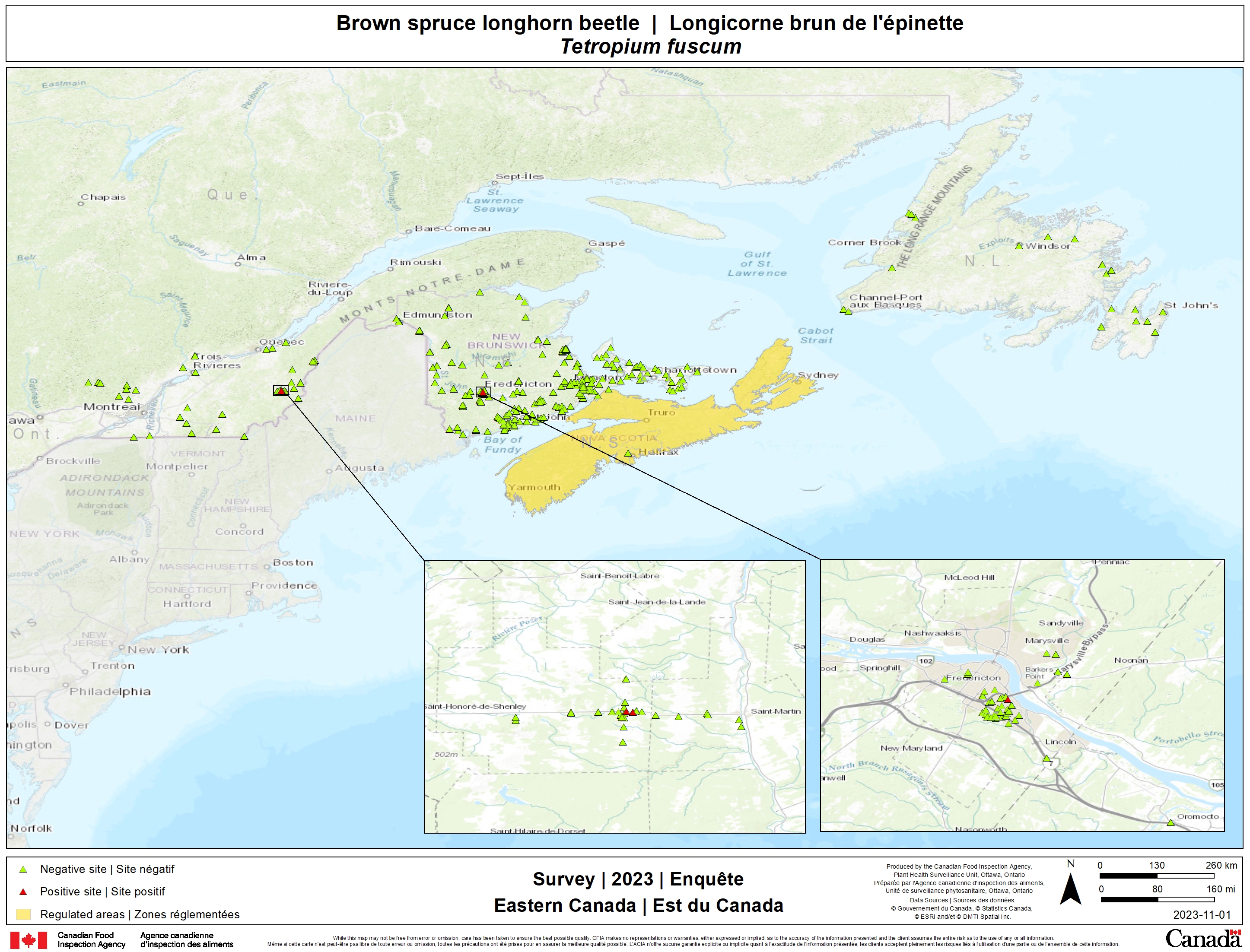
The map shows the locations of sites that have been surveyed for Brown spruce longhorn beetle in 2023, covering the provinces of Quebec, New Brunswick, Newfoundland and Labrador, and Prince Edward Island. The regulated area for this pest is shown in yellow and covers the entire province of Nova Scotia.
There are 386 negative sites shown as green triangles extending the entire area surveyed. Two red triangles indicate positive sites where the beetle was intercepted in Quebec and New Brunswick.
Hemlock woolly adelgid
The Hemlock woolly adelgid (Adelges tsugae) is a destructive pest of susceptible species of hemlock (Tsuga spp.). Native to India, Japan, Taiwan, China and western North America, it was first reported in North America in British Columbia in 1919, and occurs in Alaska, Washington, Oregon, and California. The pest was first detected in the eastern United States in 1951. Since this time, it has steadily spread and is now reported from 21 eastern states. In the eastern U.S., It has resulted in significant mortality of both eastern hemlock, (T. canadensis) and Carolina hemlock, (T. caroliniana) and threatens the existence of these 2 species in many locations. In Canada it has been detected in western Nova Scotia and in southern Ontario.
Method: Visual inspection
This survey was conducted between November and June to visually assess hemlock trees for signs and symptoms of attack. Given that the pest is most likely to spread through natural dispersal (wind, water, birds and small mammals) and through infested nursery stock, target sites included nurseries importing hemlock, urban parks and greenspaces, hemlock forest stands within 100 km of the U.S. border and/or infested counties in Canada, and hemlock forest stands along migratory bird routes.
Results from 269 sites surveyed
| Provinces | Number of sites surveyed | Results |
|---|---|---|
| Ontario | 111 | The pest was detected at 7 sites in the municipalities of Lincoln (1 site), Pelham (3), Thorold (1), Port Colborne (1), and another site close to Nanticoke in Haldimand county (1), near Lake Erie. |
| Quebec | 27 | - |
| New Brunswick | 46 | - |
| Nova Scotia | 72 | The pest was detected in 2 additional counties: Hants and Halifax counties. |
| Prince Edward Island | 13 | - |
| Canada | 269 | Additional monitoring in 2024 will help inform regulatory decisions, with increasing emphasis on building community science networks through collaborative monitoring initiatives. |
Map of results
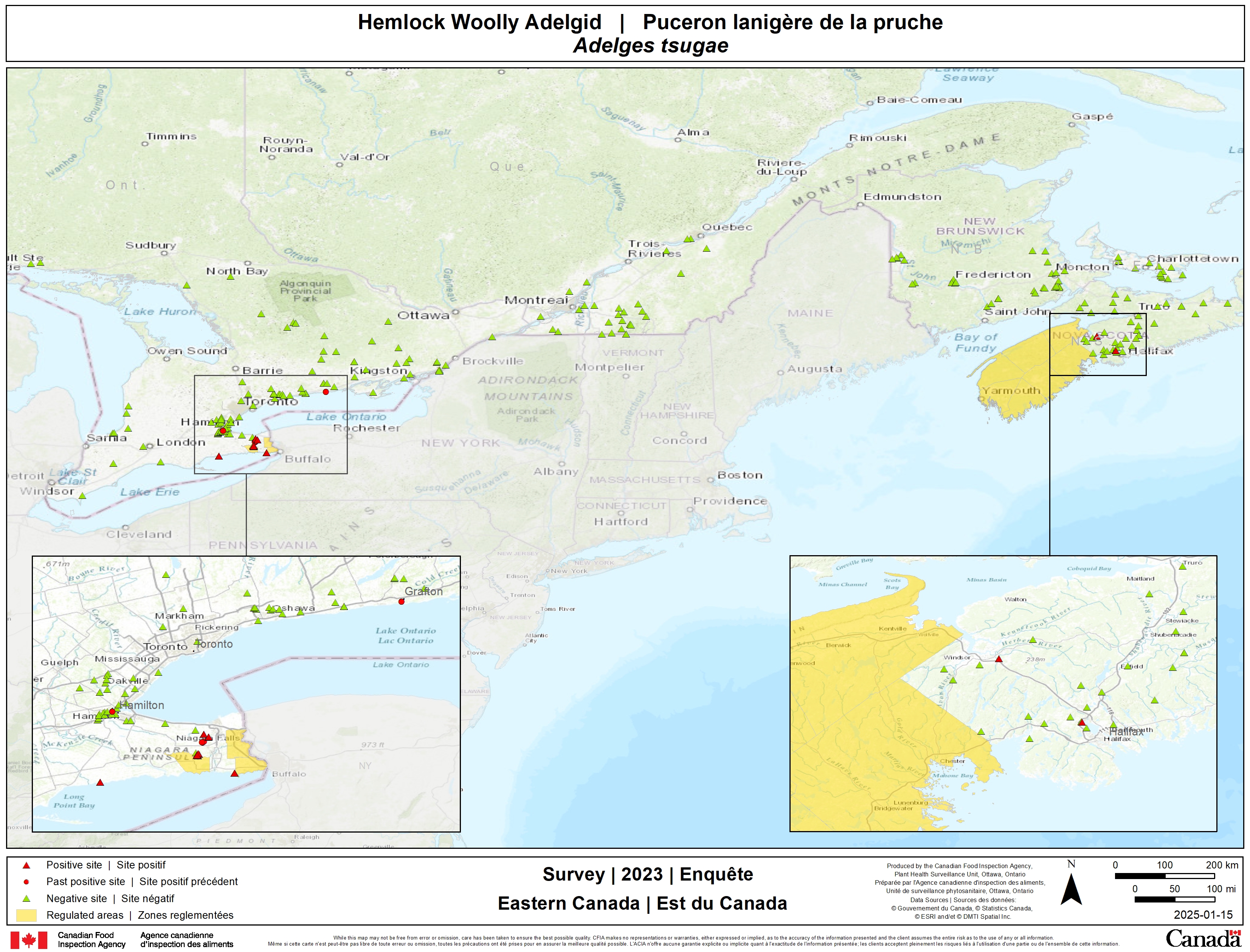
The map shows the locations of site that have been surveyed for hemlock woolly adelgid in 2023, covering Eastern Canadian provinces: Ontario, Quebec, Nova Scotia, New Brunswick and Prince Edward Island. The regulated areas for this pest are shaded with yellow and cover part of the Niagara peninsula in Ontario, and the southern peninsula of Nova Scotia.
There are 262 negative sites shown as green triangles extending the entire area surveyed. Seven red triangles indicate positive sites where the pest was detected outside the Regulated Area in Haldimand county and in the municipalities of Lincoln, Pelham, Thorold, and Port Colborne in Ontario, and in the Hants and Halifax counties in Nova Scotia. The map also shows four red dots indicating the location of previous detection in Ontario in 2022, in Hamilton, Pelham and near Grafton.
Red pine scale
The red pine scale (Matsucoccus matsumurae) is a destructive pest of susceptible species of pine that is native to Japan and introduced into China, South Korea, Europe, and the United States. It was first reported in North America in 1949 in Connecticut, but has since spread to Maine, Massachusetts, New Hampshire, New Jersey, New York, Pennsylvania, and Rhode Island. Red pine scale kills red pine (Pinus resinosa) trees of all ages within a few years of infestation.
Method: Visual inspection
This is a visual survey aimed at early detection of the pest in areas of Canada at risk to introduction. Trees are visually inspected for symptoms and signs of the pest: yellow and red foliage, decline, bark beetle attack, and cottony white filaments on branches. The optimal period for this survey is from September through October. However, surveys can occur year-round. This survey targets forest stands at risk in urban areas, near importers of pine forest products and nursery stock, and in pine stands located within 100 km of the Canada and USA border.
Results from 13 sites surveyed
| Provinces | Number of sites surveyed | Results |
|---|---|---|
| Quebec | 9 | No detections |
| New Brunswick | 4 | No detections |
| Canada | 13 | Red pine scale has never been detected in Canada |
Oak wilt
Oak wilt (Bretziella fagacearum) is a vascular wilt disease that is capable of killing trees in a single season. It was first recognized as an important forest pest in 1944 in Wisconsin and is now known to occur in 24 states within the U.S. In 2016, oak wilt was confirmed on Belle Isle (Michigan), in the middle of the Detroit River, less than 600 meters from Windsor, Ontario. Oak wilt is spread from diseased to healthy trees through root grafting and by oak bark beetles and sap beetles. All oak species are susceptible to oak wilt, but red oaks are more frequently infected and can die quite quickly. The primary goal of this survey is the early detection of the pest in areas where it is not known to occur.
Method: Visual inspection
This survey consists of a visual inspection of host trees for signs and symptoms of oak wilt. Surveys focus on areas where oak wilt could have been introduced through human-assisted movement of infected commodities from infested areas. An emphasis is placed on campgrounds where oak firewood may be transported from infected areas, mills or other facilities importing oak logs, disposal sites and areas where recent weather events may have damaged limbs/trees.
Results from 123 sites surveyed
| Provinces | Number of sites surveyed | Results |
|---|---|---|
| Manitoba | 5 | - |
| Ontario | 69 | The disease was detected at 3 locations: in the city of Niagara Falls, in the Township of Springwater and in the town of Niagara-on-the-Lake. |
| Quebec | 33 | - |
| New Brunswick | 9 | - |
| Nova Scotia | 5 | - |
| Canada | 123 |
The detections in Ontario are the first detections of oak wilt in Canada. Infected and suspected infected trees were removed and destroyed. Additional surveillance was conducted within 400m of each infested site. Additional surveys will be conducted in 2024 to verify eradication efforts, determine whether its present elsewhere in Canada, and to inform regulatory decisions. |
Map of results
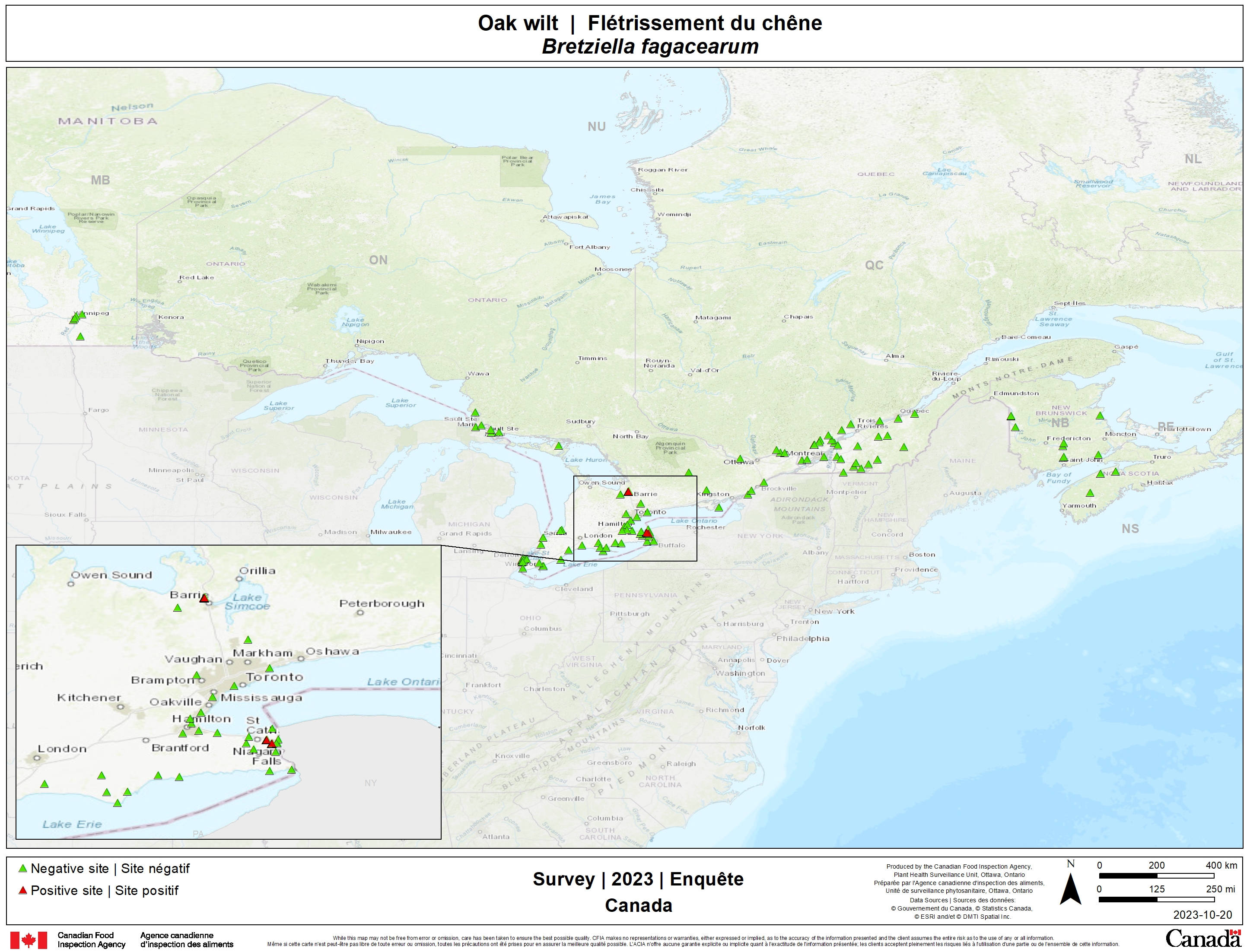
The map shows the locations of sites that have been surveyed for oak wilt in 2023 in the provinces of Manitoba, Ontario, Quebec, New Brunswick and Nova Scotia. On the map, 120 negative sites are shown by green triangles covering the surveyed area. Three red triangles show the positive sites: in the municipalities of Niagara Falls and Niagara-on-the-Lake, and in the county of Springwater.
Asian longhorned beetle
The Asian longhorned beetle (Anoplophora glabripennis) is an invasive insect that attacks and kills a wide variety of deciduous tree species. This beetle was detected for the first time in Canada in September of 2003. An eradication program was implemented and in 2020, the pest was declared eradicated from Canada based on 5 years of negative survey data and in accordance with international phytosanitary standards. Given the constant threat this pest poses to Canada, ongoing national surveillance activities are designed to ensure a high probability of detection in high-risk areas.
Method: Visual inspection
This survey is conducted through visual inspection of host trees (maple, willow, poplar, birch and elm) looking for symptoms and signs of attack by this beetle. The survey is carried out between September and December when leaves are absent, and the bark of branches located in the canopy is visible. An area-wide grid-based approach is implemented in high-risk areas and includes a variety of landscapes: residential, commercial, and industrial areas, as well as in transportation/utility corridors, forested land, and green spaces.
Results for 1,831 surveyed sites
| Provinces | Number of sites surveyed | Results |
|---|---|---|
| British Columbia | 374 | No detections |
| Alberta | 109 | No detections |
| Saskatchewan | 10 | No detections |
| Manitoba | 31 | No detections |
| Ontario | 796 | No detections |
| Quebec | 307 | No detections |
| New Brunswick | 84 | No detections |
| Nova Scotia | 82 | No detections |
| Prince Edward Island | 8 | No detections |
| Newfoundland and Labrador | 20 | No detections |
| Canada | 1,831 | Canada is considered free from Asian longhorned beetle. |
Map of results
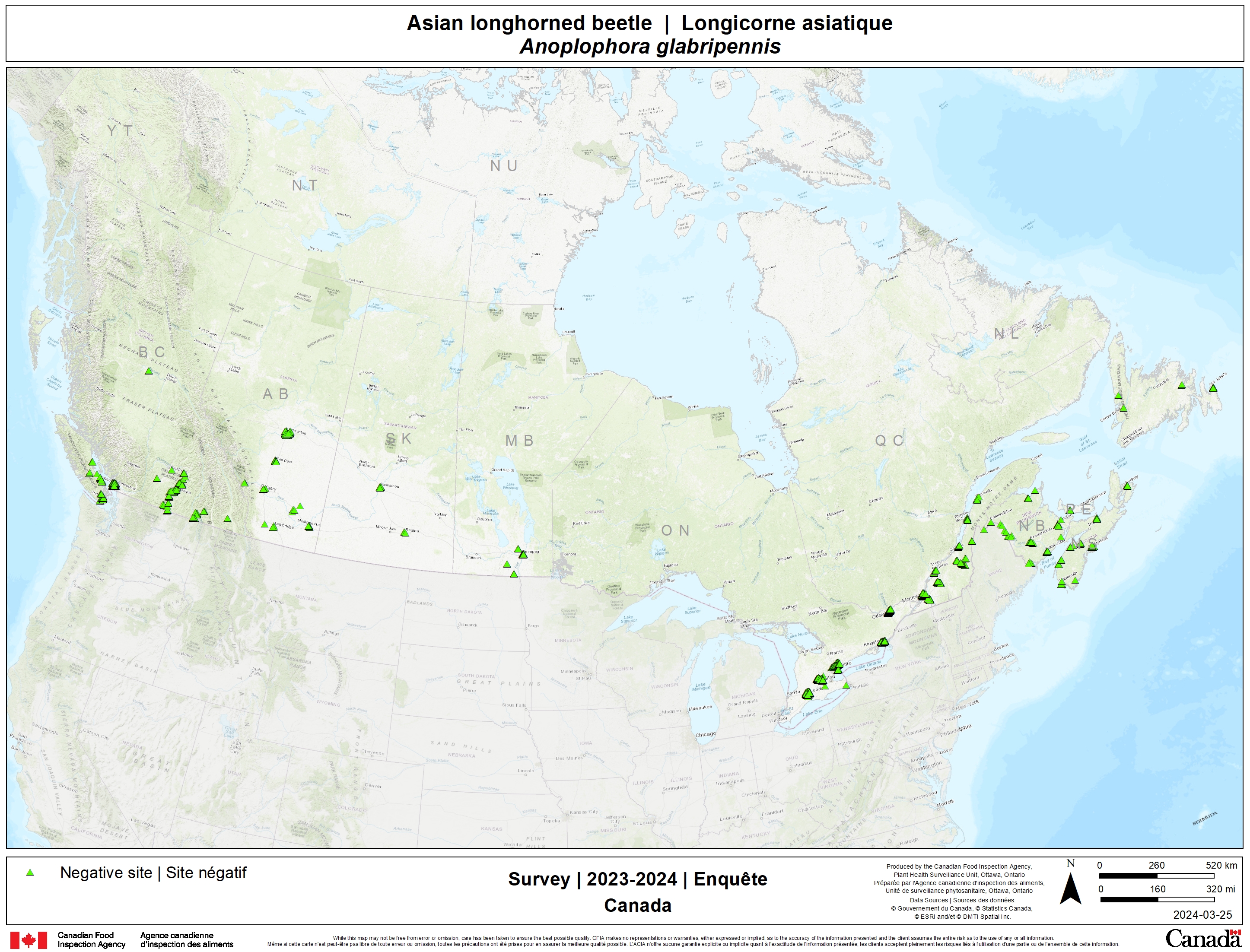
The map shows the locations of site that have been surveyed for Asian longhorned beetle in 2023, covering all Canadian provinces. There are 1,831 negative sites shown as green triangles extending the entire area surveyed.
Invasive alien forest insects
The invasive alien species forest pest surveys are pathway-based surveys designed to detect a broad range of wood borers and bark beetles. The surveys focus on urban areas where the risk of invasive alien insect introductions via international wood packaging and dunnage is greatest. The primary goal of these surveys is to detect new introductions of non-indigenous species not known to be present in Canada. The invasive alien species forest pest trapping survey provides an early warning of the presence of potentially invasive pests in Canada as well as valuable information on the diversity of Canada's insect fauna.
Method: Traps
The survey uses semiochemical-baited black (ground level), or green (canopy level) multiple funnel traps. Since 2015, traps have been baited with either the general longhorn lure (fuscumol, fuscumol acetate, ultra-high release ethanol) or the pine sawyer lure (monochamol, ipsenol, ultra-high release alpha-pinene and ultra-high release ethanol).
Results for 77 sites surveyed
| Provinces | Number of sites surveyed | Results |
|---|---|---|
| British Columbia | 13 | No detections |
| Alberta | 1 | No detections |
| Ontario | 21 | No detections |
| Quebec | 21 | No detections |
| New Brunswick | 4 | No detections |
| Nova Scotia | 12 | No detections |
| Newfoundland and Labrador | 4 | No detections |
| Canada | 77 | No new invasives pests were detected. |
Map of results
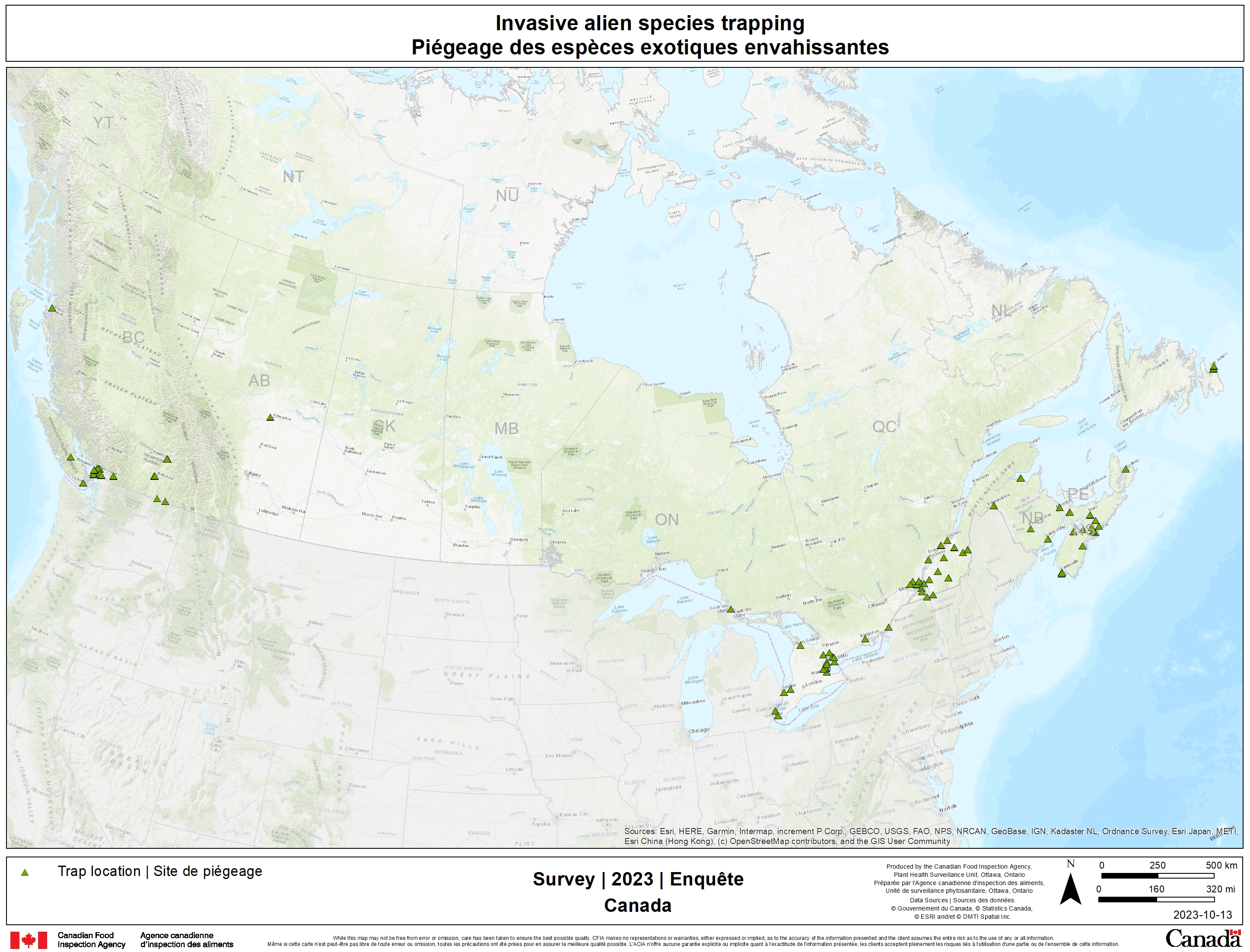
The map shows the locations of sites that have been surveyed for invasive alien forest insects in 2023 covering all provinces except Saskatchewan, Manitoba, and Prince Edward Island. There are 77 survey sites shown as green triangles and covering the area surveyed.
Horticulture pests
Japanese beetle
The Japanese beetle (Popillia japonica) has been present in Canada since its first detection in Yarmouth, Nova Scotia, in 1939. This pest affects more than 300 plant species, including many economically important plants such as fruit trees, ornamental shrubs and roses, field crops, turf grasses and sod. In 2017, Japanese beetle was detected in Vancouver, British Colombia, and a multi-collaborator eradication program has been ongoing since 2018. The trapping efforts in 2018 resulted in the collection of 8,276 beetles. This number went down, following yearly treatments, to 1,157 (2019), 214 (2020) and 79 (2021). In 2022, a total of 201 beetles were caught, most of them in a new satellite infestation in Port Coquitlam, British Colombia. In 2023, most beetles were again found in the new satellite infestation in Port Coquitlam.
Method: Traps
This survey is conducted using pheromone traps which were installed in May and remained in the field until October. The traps contain a Japanese beetle attractant which is a combination of a floral lure and a pheromone. In the greater Vancouver area, where eradication is in progress, traps are deployed at various densities, with infested municipalities having the highest density of traps. For other locations in Canada, traps are placed adjacent to, or near importers of sod, soil or nursery stock from Japanese beetle infested areas and include sites such as nurseries, sod farms, golf courses, cemeteries, public parks and gardens, food terminals, truck and rail compounds/terminals, airports and border points.
Results from 5,290 sites surveyed
| Provinces | Number of sites surveyed | Results |
|---|---|---|
| British Columbia | 5,191 |
A total of 644 beetles were captured in 72 traps:
|
| Alberta | 9 | - |
| Newfoundland and Labrador | 90 | One beetle was captured in St John's |
| Canada | 5,290 | We continue to support our collaborators in their effort to eradicate the pest. Trapping efforts will continue in the greater Vancouver area and around new satellite infestations. |
Map of results
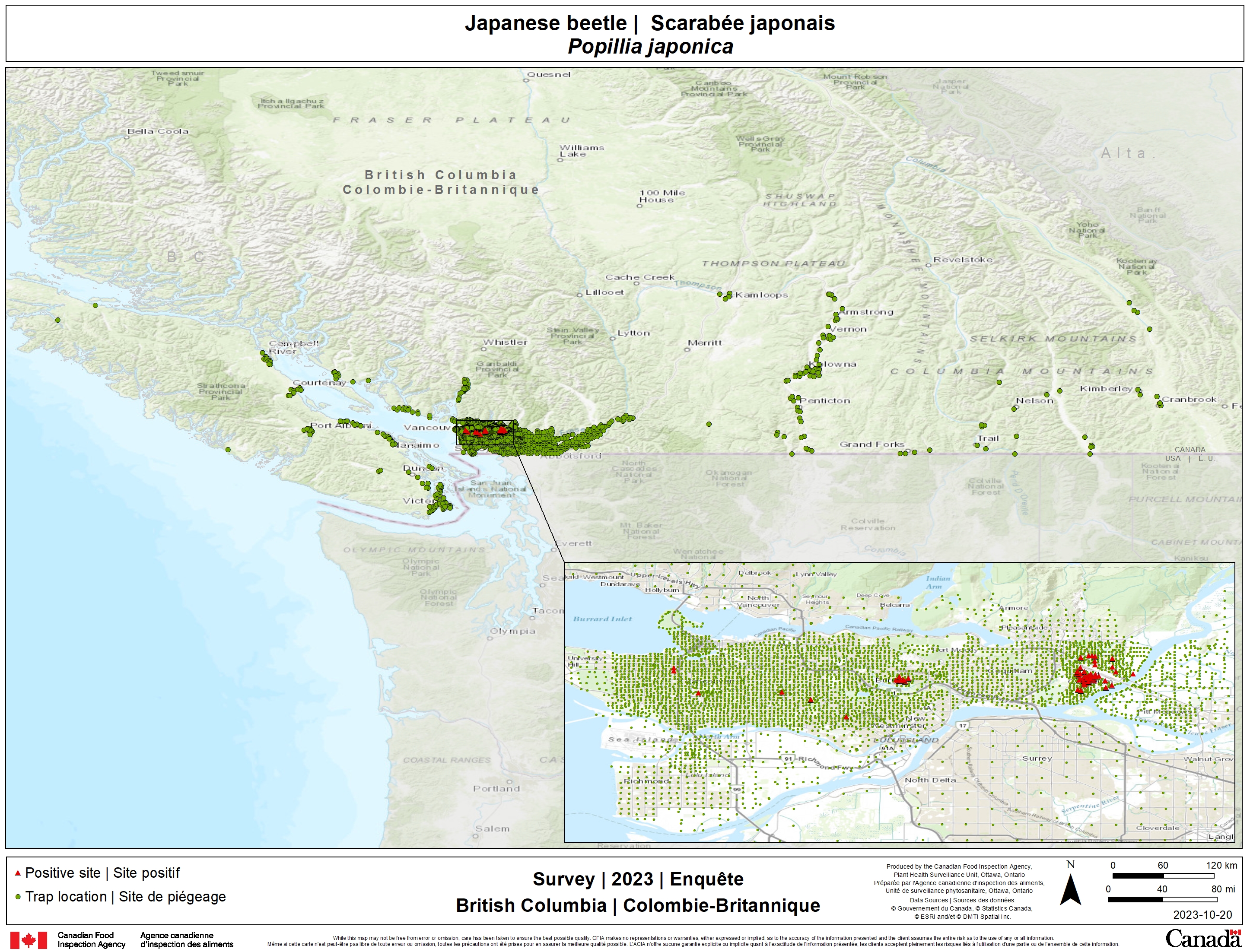
The map shows the locations of sites that have been surveyed for Japanese beetle in British Columbia in 2023.
There are 5,119 negative sites shown as green triangles extending the entire area surveyed in British Columbia. On the map, 72 red triangles indicate positive sites where the pest was detected in Vancouver, Burnaby and Port Coquitlam in British Columbia.
Ramorum blight
Phytophthora ramorum is a plant pathogen that causes a disease known as Ramorum blight on a wide variety of nursery plants. It has also been associated with a disease of oak, known as "Sudden Oak Death", that was first observed in coastal California in the mid-1990's. Since 2003, Ramorum blight has been detected in a number of retail/wholesale nurseries in the southern coastal area of British Columbia. The primary goal of this survey is to provide information on the national status of this disease in Canadian nurseries. More specifically, monitoring of Ramorum blight is required to support eradication programs and detect new infestations.
Method: Visual inspection
The focus of this survey is to visually inspect high-risk host plants at target facilities and to collect samples with symptoms consistent with expression of Ramorum blight infection. The survey targets nurseries that propagate the host plants listed in D-01-01: Phytosanitary requirements to prevent the entry and spread of Phytophthora ramorum and nurseries that grow Ramorum blight host plants beyond the year of import or propagation, including wholesale nurseries.
Results from 35 surveyed sites
| Provinces | Number of sites surveyed | Results |
|---|---|---|
| British Columbia | 21 | No new detections. |
| Ontario | 10 | No new detections. |
| Quebec | 4 | No new detections. |
| Canada | 35 | There are no changes to the status of this pest in Canada. |
Blueberry maggot
The blueberry maggot (Rhagoletis mendax) is an indigenous pest of commercially grown lowbush and highbush blueberries in the Canadian Maritime Provinces. It is currently found in Nova Scotia, New Brunswick, Prince Edward Island and parts of Ontario and Quebec. It is not found in Newfoundland & Labrador or in western Canada.
Method: Traps
This survey is conducted with the use of baited traps which are attractive to male and female blueberry maggot adult flies. Multiple traps are placed within blueberry plantations and wild sites containing host species in areas not regulated for blueberry maggot. Traps are installed prior to the pest's flight period in late June and collected at the end of harvest or fruit drop, in late August or early September.
Results from 81 surveyed sites
| Provinces | Number of sites surveyed | Results |
|---|---|---|
| British Columbia | 28 | No new detections outside the known infested areas. |
| Ontario | 17 | No new detections outside the known infested areas. |
| Quebec | 12 | No new detections outside the known infested areas. |
| Newfoundland and Labrador | 24 | No new detections outside the known infested areas. |
| Canada | 81 | Regulated areas remain unchanged. |
Map of results
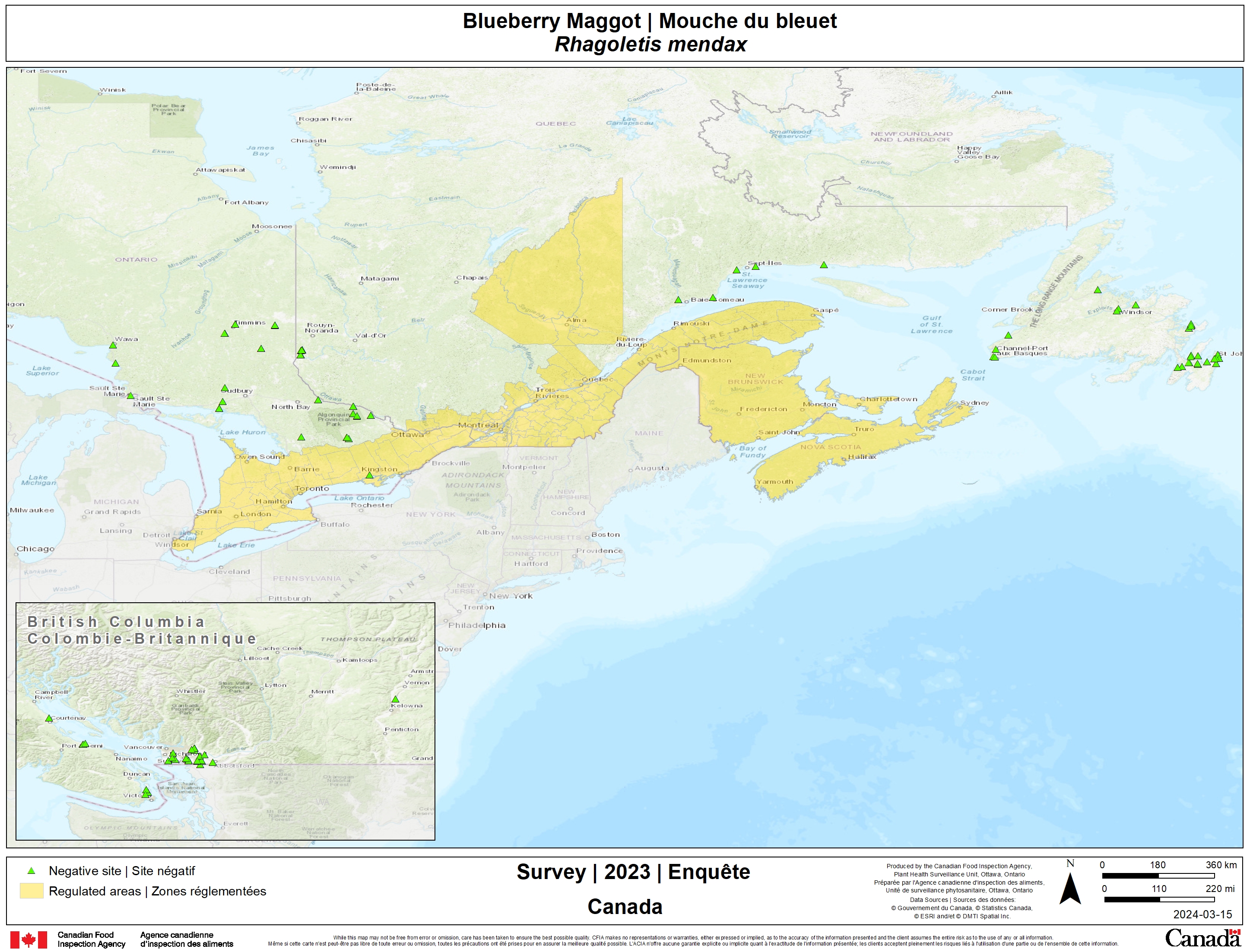
The map shows the locations of sites that have been surveyed for blueberry maggot in Canada in 2023, in the provinces of British Columbia, Ontario, Québec and Newfoundland and Labrador. The regulated areas for the blueberry maggot are shaded in yellow and cover the entire provinces of New Brunswick, Nova Scotia and Prince Edward Island, and parts of Ontario and Quebec.
There are 81 negative sites shown as green triangles extending the entire area surveyed.
Apple maggot
Apple maggot (Rhagoletis pomonella) is an indigenous pest of apples in Canada. The BC Interior is the last major apple growing area of North America free from this pest. The objective of this survey is the early detection of apple maggot to maintain the pest-free area of the BC Interior. This survey is being conducted in support of policies and programs related to CFIA policy directive D-00-07: "Import and domestic phytosanitary requirements to prevent the introduction and spread of apple maggot (Rhagoletis pomonella (Walsh)". In 2015, a single female apple maggot was detected in West Kelowna and in 2016 another single female was detected in the city of Kelowna. Despite increased surveillance from 2016 to 2019 apple maggot has not been detected since 2016.
Method: Traps
This survey is conducted using sticky red spheres baited with an attractant and placed in host plants between June and September, when adult apple maggot flies are active. Traps are deployed to give an optimal coverage of known pome fruit production areas and associated urban and rural properties with suitable hosts, as well as riparian areas. The survey also includes selected sites that are perceived to be high risk for introduction of the pest.
Results from 444 surveyed sites
| Provinces | Number of sites surveyed | Results |
|---|---|---|
| British Columbia | 444 |
No new detections in the pest free area and outside the known infested areas. The pest free area in the interior of British Columbia is considered free from apple maggot. |
Map of results
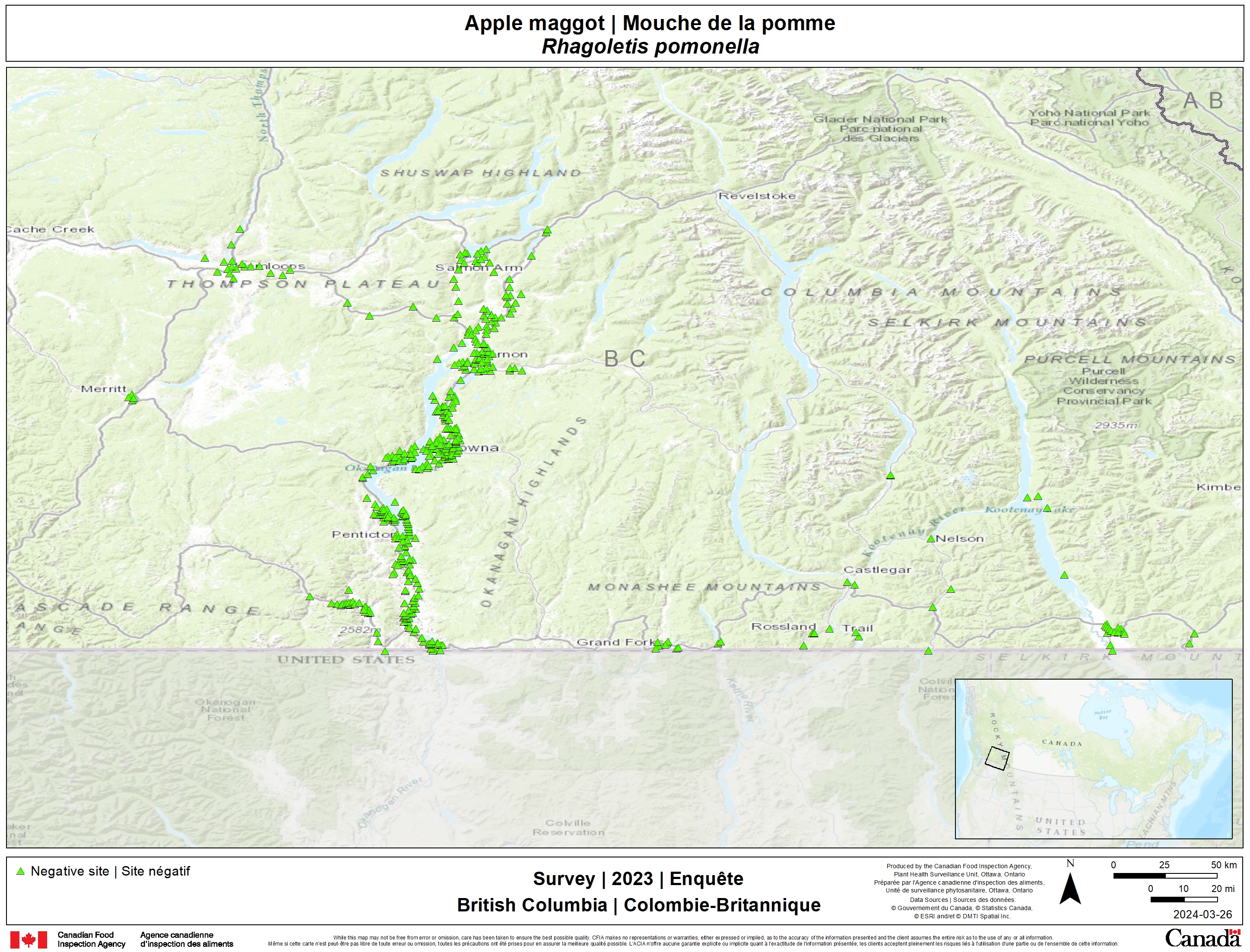
The map shows the locations of sites that have been surveyed for apple maggot in British Columbia, Canada, in 2023. There are 444 negative sites shown as green triangles extending the entire area surveyed.
Plum pox virus
Plum pox virus is a serious plant disease that affects many stone fruit species within the genus Prunus, including peaches, nectarines, plums, apricots, almonds and some ornamental varieties. Although it does not kill trees, it reduces the marketability of the fruit, causes early fruit drop in infected trees and drastically reduces fruit yields. Plum pox virus is present in the Niagara area.
Method: Leaf sampling
Leaf sampling of select orchard and homeowner properties is done to ensure continued monitoring along the boundary of the plum pox virus regulated area. In addition, propagation inspections are completed at select orchards and homeowner properties to verify compliance with the Prunus propagation ban. Depending on the location, these two types of surveys are performed every year or on a rotational basis of two or three years.
Results from 2,116 sites surveyed
| Provinces | Number of sites surveyed | Results |
|---|---|---|
| Ontario | 2,116 |
225 orchards and 1,891 residential properties were visited and sampled. There were no detections. The regulated areas remain unchanged. |
Tobacco blue mold
Tobacco blue mold (Peronospora hyoscyami f.sp. tabacina) is a serious disease of solanaceous plants including tobacco, peppers, tomato and eggplant. Tobacco blue mold is only reported from Eastern Canada, although there was one report of the disease in Washington State in the 1950's. This pathogen is not known to overwinter in Canada but may be blown in as spores from the Southeastern US.
Method: Visual inspection
This survey was conducted in cooperation with Agriculture and Agri-Food Canada (AAFC). Visual surveys were conducted on indicator plants (Tobacco blue mold-sensitive tobacco, Nicotiana tabacum) at three sites in southwestern British Columbia.
Results from 3 surveyed sites
| Provinces | Number of sites surveyed | Results |
|---|---|---|
| British Columbia | 3 | No detections. There are no changes to the status of tobacco blue mold in Canada. |
Box tree moth
The CFIA has been leading monitoring efforts to determine the distribution of box tree moth (Cydalima perspectalis), working with community scientists and collaborators to deploy traps across Canada. Volunteers with boxwood in key areas were recruited via social media and collaborator networks. The 2023 monitoring program expanded in response to new detections, using additional pheromone traps to assess for adult box tree moth presence nationally. Traps were distributed to volunteer community scientists in support of this objective, with CFIA enhancing efforts in key areas as needed.
Method: Visual inspection and traps
Monitoring kits were comprised of traps with sticky liners, lures, pest detection cards, and instructions on how to complete data entry using an online community science platform. Trapping was conducted between May and late September when adults are actively flying. A combination of pheromone lures was used to ensure coverage over the duration of the flight period; "Milk carton" traps with trap openings enlarged to enhance trap captures and optimize detection efficacy were used to ensure easy shipping and disposal. Volunteers were engaged at regular intervals to ensure timely trap checks and lure changes. Traps were checked weekly for the presence of moths and pheromone lures were changed once in August. Data entry was completed weekly and any suspect moth findings were photographed, and site visits were conducted by the CFIA to confirm reports in new areas.
Results from 280 sites surveyed
| Provinces | Number of sites surveyed | Results |
|---|---|---|
| British Columbia | 143 | No detections Survey done in partnership with volunteer community scientists and with the British Columbia Landscape and Nursery Association and Ministry of Agriculture and Food, with field work done by Invasive Species Council's Insect Ambassadors. |
| Ontario | 11 | 2 detections |
| Quebec | 51 | 8 detections |
| New Brunswick | 26 | 3 detections |
| Nova Scotia | 24 | 1 detection |
| Prince Edward Island | 15 | No detections |
| Newfoundland and Labrador | 10 | No detections |
| Canada | 280 | The regulated areas for box tree moth have been expanded to reflect detections of this pest in new areas. |
Invasive plants
Invasive plant survey priorities are established by the Invasive Alien Species and Domestic Plant Health Programs at the CFIA. For more information on these survey results or methods, contact the Invasive Alien Species and Domestic Plant Health Programs Section.
Japanese stiltgrass
Japanese stiltgrass (Microstegium vimineum) is an invasive plant found in a variety of habitats, including forests, wetlands and disturbed areas. This plant's prolific seed production and rapid growth helps it dominate entire habitats, edging out native vegetation. As it spreads, Japanese stiltgrass displaces nesting sites for birds and other wildlife. Economically, Japanese stiltgrass may also cost producers due to control costs and productivity losses. Native to Asia, this plant has been introduced into the United States and is found in Ohio, Pennsylvania and along the US Atlantic coast. Seven populations have been confirmed in southern Ontario: two in Elgin County, two in Norfolk County, one in Waterloo region, and two in Niagara region. It has not been found in any other locations in Canada.
Method: Visual inspection
This survey prioritizes areas where seeds may have been dispersed from the known infestations. Suitable locations may include pastures and fields, rails, recreational and naturalized tourist areas, parks, shaded roadside ditches, forests, woodlands and disturbed areas, particularly those with known deer populations. Visual inspections are conducted within a 200 m radius of preselected sites. Suspect plants are collected and sent to our laboratories for identification.
Results from 17 sites surveyed
| Provinces | Number of sites surveyed | Results |
|---|---|---|
| Ontario | 17 |
Two new detections were identified. One in Norfolk County and one in Niagara Region The newest positive detections were identified through reports from the public. The CFIA is working with collaborators on the management of Japanese stiltgrass in Ontario. |
Map of results
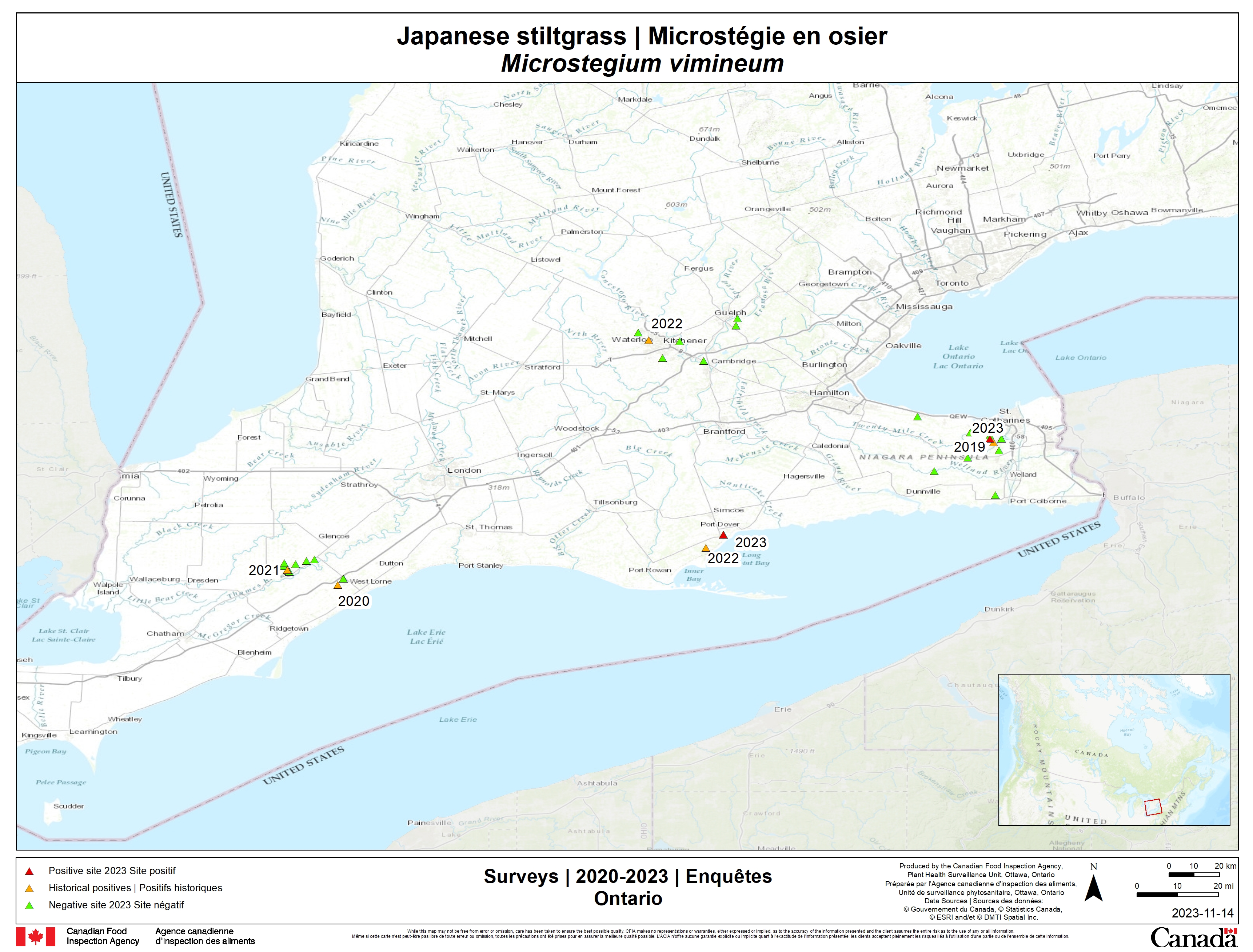
The map shows the locations of sites that have been surveyed for Japanese stiltgrass in Ontario, Canada, in 2023. There are 17 negative sites shown as green triangles extending the entire area surveyed. Two red triangles show new detections in 2023, one in Norfolk County and one in Niagara Region. The map also shows five orange triangles where detections occurred between 2019 and 2022.
Seed and grain handling facilities
One of the major pathways of introduction of invasive alien plants into Canada is through contaminated lots of imported seed and grain. The main objectives of this survey are to detect new populations of the target plant species and to provide information in support of the development of regulatory policies on invasive alien plants. See the list of priority species targeted for this survey.
Method: Visual inspection
This visual survey is divided into early and late summer surveys to maximize the period during which the presence of inflorescences makes the weeds easier to detect. The survey is conducted at seed and grain storage, handling, cleaning, and processing facilities (e.g., elevators, flour mills, oil crushers, seed cleaners, feed mills including bird seed, etc.). The area surveyed includes the facility site, as well as waste areas and ditches adjacent to those sites. The inspection includes areas where auger or conveyer belt dust and debris have settled, loading and unloading sites, and composting/disposal locations.
Results from 116 sites surveyed
| Provinces | Number of sites surveyed | Results |
|---|---|---|
| British Columbia | 9 | No detections |
| Alberta | 15 | No detections |
| Saskatchewan | 10 | No detections |
| Manitoba | 10 | No detections |
| Ontario | 33 | No detections |
| Quebec | 26 | No detections |
| New Brunswick | 7 | No detections |
| Nova Scotia | 2 | No detections |
| Prince Edward Island | 4 | No detections |
| Canada | 116 | There were no detections of invasive plants during this survey. |
Potato pests
Potato wart
Potato wart disease, also known as potato canker, is caused by Synchytrium endobioticum, a soil-borne fungus. Potato (Solanum tuberosum) is the only cultivated host. The fungus attacks the growing points on the potato plant, such as eyes, buds and stolon tips. The fungus can remain dormant in the soil for more than 40 years as resting spores. In Canada, potato wart is present in Prince Edward Island and in Newfoundland and Labrador. The purpose of this survey is to monitor for the presence of Synchytrium endobioticum outside of Newfoundland and Labrador and PEI restricted fields. This survey is in addition to any sampling and analysis associated with potato wart restricted fields in PEI.
Method: visual inspection and soil sampling
Two main strategies were used for potato wart detection in Canada:
- Visual inspection of tubers
- Soil sampling
Suspect tubers and soil samples are sent to a CFIA laboratory for analysis. The survey is conducted by sampling soil from potato fields in areas where potato wart is not known to occur. Soil is collected using a regular grid pattern, known as grid soil sampling, or collected from underneath equipment as it falls from tubers as potatoes move into storage, known as tare soil sampling. Each soil sample collected represents approximately 1 acre of potato production.
Results from 2,062 samples collected
| Provinces | Number of samples collected | Results |
|---|---|---|
| British Columbia | 14 | No detection. Collected from seed production fields using grid soil sampling. |
| Alberta | 232 | No detection. Collected from seed production fields using grid soil sampling. |
| Saskatchewan | 59 | No detection. Collected from seed production fields using grid soil sampling. |
| Manitoba | 136 | No detection. Collected from seed production fields using grid soil sampling. |
| Ontario | 235 | No detection. Collected from seed production fields using grid soil sampling. |
| Quebec | 170 | No detection. Collected from seed production fields using grid soil sampling. |
| New Brunswick | 590 | No detection. Collected from seed production fields using grid soil sampling. |
| Nova Scotia | 49 | No detection. Collected from seed production fields using grid soil sampling. |
| Prince Edward Island | 577 | No detection. Collected from unrestricted fields with all types of potato production using tare soil sampling. |
| Canada | 2,062 | There are no changes to the status of this pest in Canada. |
Potato cyst nematode
Golden nematode and pale cyst nematode are two species of potato cyst nematode (PCN) that are quarantine pests in Canada. If left unmanaged, they can reduce yields of potatoes and other host crops such as tomatoes and eggplants by up to 80 percent. These pests infest the soil and are very difficult to eradicate because they can persist, dormant in the soil, for several decades. They do not pose a risk to human health. Both of these quarantine potato cyst nematodes have been confirmed in 65 countries worldwide, including the United States and Canada.
Method: Soil sampling
Soil sampling is conducted each year across Canada for either regulatory purposes or to certify seed potato shipments. A regular grid pattern is used to collect soil samples from the fields. Each soil sample collected represents approximately 1 acre of potato production.
Results from 11,441 samples collected
| Provinces | Number of samples collected | Results |
|---|---|---|
| British Columbia | 108 | No detection. Samples were collected for the certification of seed potato shipments. |
| Alberta | 5,187 | No detection. Samples were collected for the certification of seed potato shipments. |
| Saskatchewan | 2,986 | No detection. Samples were collected for the certification of seed potato shipments. |
| Manitoba | 1,107 | No detection. Samples were collected for the certification of seed potato shipments. |
| Ontario | 337 | No detection. Samples were collected for the certification of seed potato shipments. |
| Quebec | 437 | No detection. Samples were collected for the certification of seed potato shipments. |
| New Brunswick | 1,128 | No detection. Samples were collected for the certification of seed potato shipments. |
| Nova Scotia | 65 | No detection. Samples were collected for the certification of seed potato shipments. |
| Prince Edward Island | 84 | No detection. Samples were collected for the certification of seed potato shipments. |
| Newfoundland and Labrador | 32 | No detection. Samples were taken within the regulated area to support seed potato certification. |
| Canada | 11,441 | There are no changes to the status of this pest in Canada. |
Other pests of concern
Spotted lanternfly
The spotted lanternfly (Lycorma delicatula) is a colourful insect native to Asia that has been recognized as a potential threat to the grape, fruit tree and forestry industries in Canada. It was first detected in North America in Pennsylvania in September 2014. It is not known to be present in Canada and in 2018 it was added to the regulated pest list to prevent its introduction from infested areas.
Method: Visual inspection and traps
Two strategies were used for spotted lanternfly detection in Canada:
- visual inspection of plant hosts and non-plant hosts in high-risk areas.
- trapping in high-risk areas using sticky traps on selected host trees.
This survey targets known infestations of the non-native tree of heaven and where there is travel/tourism from United States, including but not limited to railyards, campgrounds, conservation areas, provincial parks, rest stops, forests near the U.S.-CAN border, particularly those in proximity to major transportation corridors and rail lines. Other preferred hosts can also be examined in the absence of the main host. Various survey activities are conducted year-round to coincide with the life stage of the pest.
Sites surveyed for Asian long-horned beetle were also visually surveyed for signs and symptoms of spotted lanternfly.
Results for 2,125 sites surveyed
| Provinces | Number of sites surveyed | Results |
|---|---|---|
| British Columbia | 391 | No detections |
| Alberta | 110 | No detections |
| Saskatchewan | 11 | No detections |
| Manitoba | 39 | No detections |
| Ontario | 1,025 | No detections |
| Quebec | 326 | No detections |
| New Brunswick | 88 | No detections |
| Nova Scotia | 86 | No detections |
| Prince Edward Island | 15 | No detections |
| Newfoundland and Labrador | 20 | No detections |
| Canada | 2,125 | Despite reported sightings (photograph) and interceptions (identification confirmed) of many dead and live adults in 2023 in several provinces, no established populations were detected. Canada is still considered free from spotted lanternfly. |
Map of results
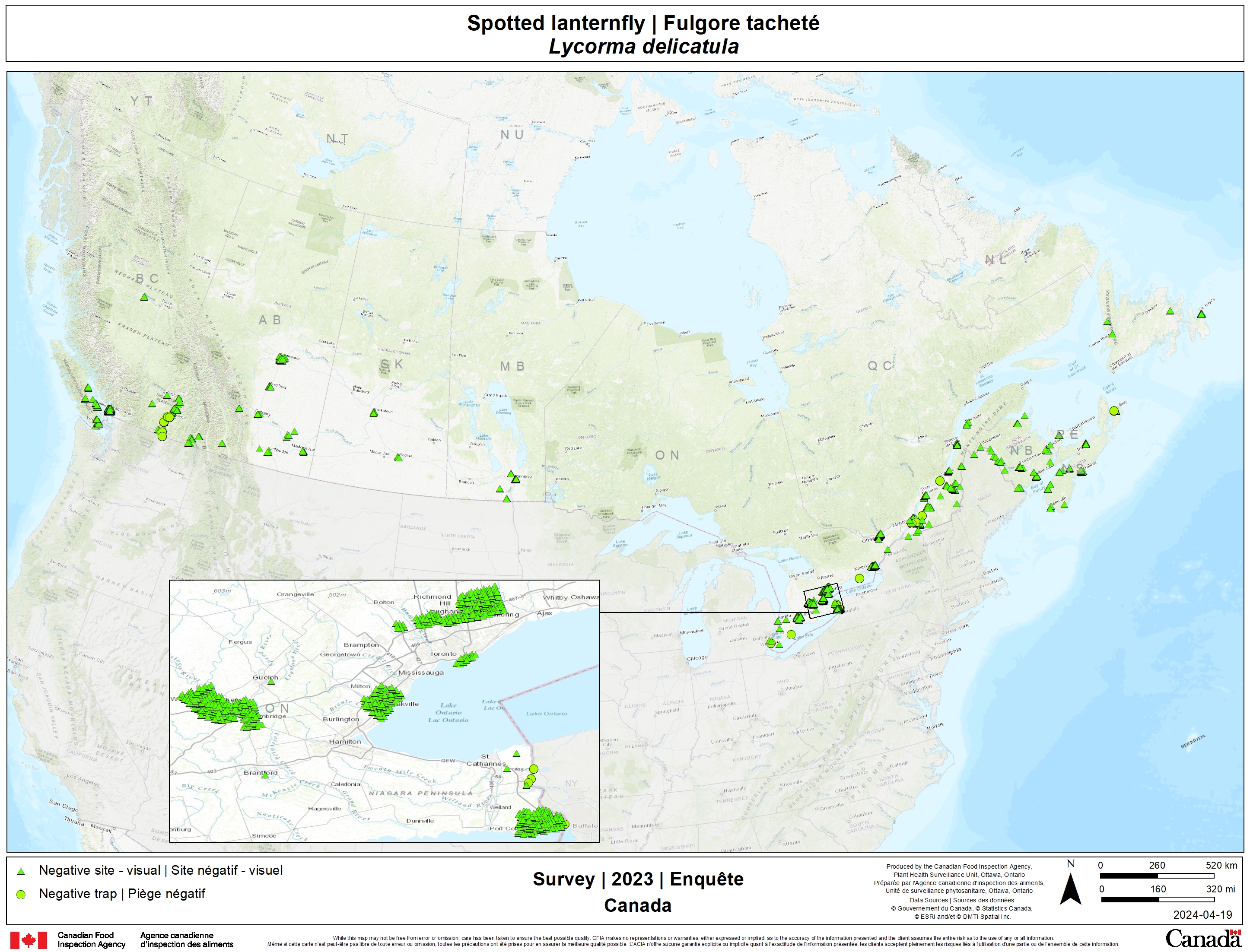
The map shows the locations of site that have been surveyed for spotted lanternfly in 2023, covering all Canadian provinces. There are 2,125 negative sites shown as green triangles (negative visual sites) and green circles (negative trapping sites) extending the entire area surveyed.
About us
Public inquiries
Every year we follow up on observations submitted by members of the public who are concerned about potential invasive alien species. Reports of suspect plant pests require technical analysis and response in real-time to ensure that potential risks can be managed, particularly for new finds, outside established infestations and/or regulated areas. In 2023-2024 we receive 785 such requests, including some significant reports that helped inform regulatory decisions.
These observations highlight the important role the public can play in the early detection of pests of potential significance to Canada.
| Provinces | Number of inquiries | Results |
|---|---|---|
| British Columbia | 18 | In addition to this number, over 200 inquiries were made related to the Japanese beetle eradication program in Vancouver and surrounding municipalities. |
| Alberta | 1 | |
| Saskatchewan | 2 | |
| Manitoba | 2 | |
| Ontario | 605 | Following the confirmation of oak wilt in Ontario, an awareness campaign was launched and CFIA received a total of 496 inquiries related to this disease. Through a public inquiry, one small and isolated woolly cup grass (Eriochloa villosa) population was detected in Chester, Ontario in 2023. This population has been controlled and will continue to be monitored. |
| Quebec | 36 | |
| New Brunswick | 49 | |
| Nova Scotia | 42 | |
| Prince Edward Island | 11 | |
| Newfoundland and Labrador | 19 | |
| Canada | 785 | From this number, 243 public reports related to box tree moth were submitted to CFIA in 2023 of which 195 were confirmed to be box tree moth. |
Supporting innovation and collaboration
We are dedicated to preventative science and research that support risk mitigation and early detection. Projects we supported in 2023-2024 to help refine our methods and optimize detection efficacy include:
- collaborating with Natural Resources Canada-Canadian Forest Service and Invasive Species Centre on an eDNA community science initiative to support an early warning system for Hemlock Woolly Adelgid
- collaborating with Natural Resources Canada-Canadian Forest Service to improve detection survey methodology of wood boring insects by conducting field research in Europe, Asia and North America
- evaluating operational survey techniques for the spotted lanternfly
- searching for hemlock woolly adelgid biocontrol agents and developing tools to detect and quantify predatory fly populations (Leucotaraxis spp.)
- assessing the placement of Japanese beetle traps in canopy to improve detection.
- evaluating the efficacy of different trap types for Japanese beetle
- evaluating a LED-based light trap for surveillance in high-risk areas
- supporting biological studies led by Canadian Forest Service to rear wood boring insects from suspect trees for the detection of the brown spruce longhorn beetle
- purchasing trapping supplies for partners to enhance surveillance capacity for emerging threats
- supporting European field trials to gather data on potential threats
- supporting Canadian Forest Service-led study for optimization of spongy moth surveys.
- supporting ongoing research to mitigate risks associated with oak wilt spread via sap beetle vectors, and to improve field sampling methodology for oak wilt detection.
We are committed to building and maintaining collaborative networks through innovative education, outreach and awareness strategies that enhance survey capacity and strengthen response efforts.
Collaborative projects with non-profits and federal partners have continued and several memorandums of understanding for data sharing with provinces have been established. We regularly hold training and outreach events with the public and stakeholders, in addition to providing internal training for CFIA inspectors.
Please contact us if you or your organization would like to receive support for training or public outreach events.
Contact us
For any questions regarding CFIA's plant protection surveys, contact cfia.surveillance-surveillance.acia@inspection.gc.ca.